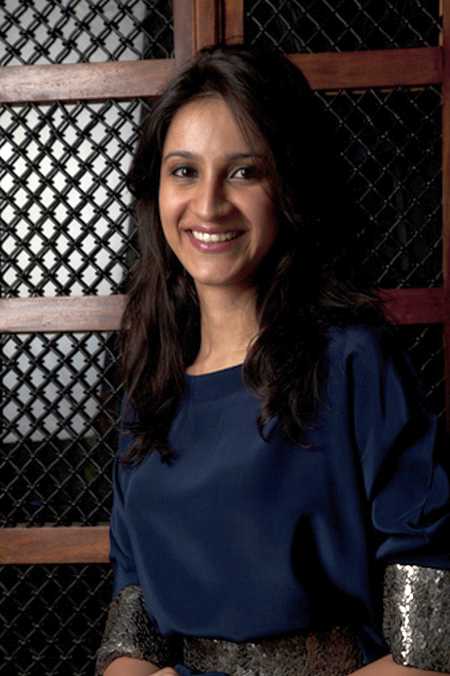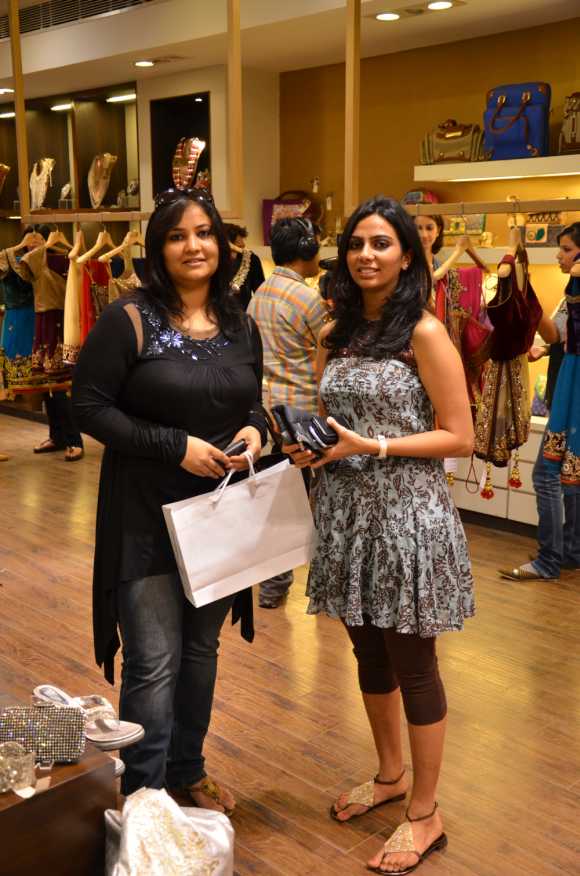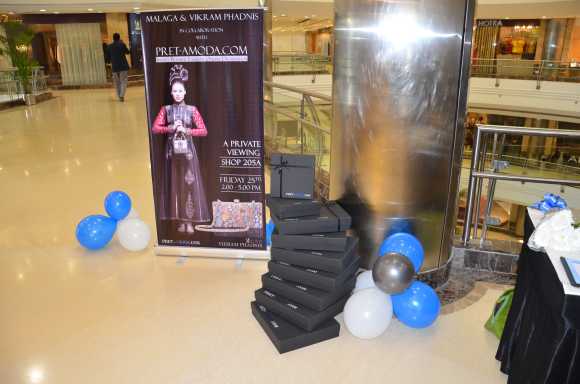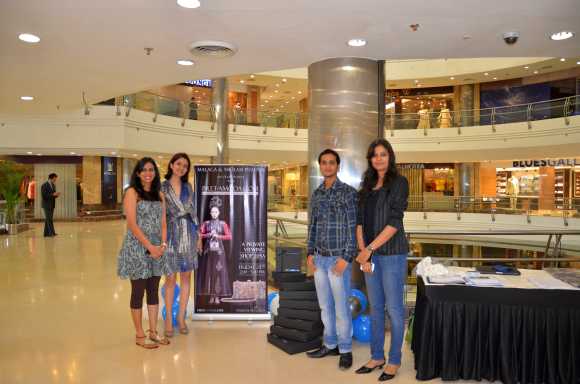Prasanna D Zore
29-year-old fashion entrepreneur Ritika Walia who came to India from London during the global economic meltdown to give entrepreneurship a try, speaks about the odds in her journey and how she overcame it.
Which venture is safe to begin with?" counters 29-year-old Ritika Walia who plunged into the rough and tumble of entrepreneurship in 2009. That was the time when India'e economy was still reeling under the onslaught of a global economic meltdown and start-ups around the world were looking at a bleak future.
But Ritika, who studied economics from University College, London, and then worked as an investment banker with Deutsche Bank for a year, had other plans. She came to India from London to try and establish a business modelled around selling luxury fashion clothing from Indian designers via an online presence.
When she began speaking with Indian fashion designers in 2009 about this concept the response she elicited was not too encouraging. The analyses and the statistical data about the market for online luxury fashion buying she presented to these designers was too difficult for them to digest. What made matters difficult for her, says Ritika, was the fact that there were not many takers for all this gyaan coming as it were from a woman.
"I think they (the designers who did not believe in her concept) were a bit thrown off in the sense that 'can I actually believe in what she is saying?'," says Ritika while articulating the challenges she faced while rolling out her operations.
However, she was a staunch believer in her ideas and knew that the number of Internet users – and so the potential buyers for her business -- will only balloon over time and designers too would come on board sensing an opportunity to create value for Indian customers and showcase their creativity to a global audience.
"But once the first established designers, my evangelists, came on board then on it was pretty much smooth sailing," says Ritika whose company Pret Amoda has not broken even despite 18 months of operations. But that is around the corner, feels Ritika.
She spoke to Prasanna D Zore on how she made her dream enterprise a reality and dishes out advice to those who want to become entrepreneurs.
'I wanted to be in the thick of the Indian fashion industry'
Image: From right: Nidhi Maheshwari, marketing head, Pret Amoda at an offline event with a customerYour educational and academic background...
I am a science student and have done my schooling from New Delhi. Then I went on to do economics at University College, London. I tried my hand at investment banking at Deutsche Bank in London. I didn't find it quite as appealing as I thought it would be. I didn't see myself growing as an investment banker. I myself had a very creative bend of mind. The reason for doing science in school was to try and get into architecture but I sort of changed that because economics was a much shorter degree to do: three years as opposed to five years for architecture.
After completing my graduation in economics and being a year into investment banking I decided to pursue luxury fashion management. My aim then was to work for world-renowned luxury brands so I went on to do my masters in that from the Polimoda Instutite in Florence, Italy. Soon after that I moved back to London to join Burberry as their ladies-wear merchandiser.
So all my knowledge as a student of economics and as an investment banker has helped me to set up Pret Amoda today.
What made you try your luck with entrepreneurship?
I worked in the fashion industry in London for close to six years. After Burberry I went on to join Alfred Dunhill. I have always been in the luxury apparel and accessories industry. These companies have been using e-commerce since a long time before it came to India. I am myself a very, very frequent online shopper for anything from groceries to apparel. When I came to India in 2008 my first thought was why not start this business model in India and let Indian consumers buy luxury fashion online.
I wanted to be in the thick of the Indian fashion industry. I had contacts already and soon I started work with Manish Arora in 2009 and got into the day-to-day working of retail operations. This beginning gave me a lot of insight into how Indian designers actually work with respect to production, timelines, actual deliveries and international forecasting. Retail (operations) in India is very different from retail in Europe.
'India is very unorganised and fragmented whether it is luxury, premium or mass-market fashion'
Image: Offline Event - Pret-amoda/com in collaboration with Designers Malini Ahluwalia and Vikram Phadnis to launch their wedding collection in DelhiWhat are the key distinctions between the Indian and European retail markets in luxury fashion?
The starkest difference is India is very unorganised and fragmented whether it is luxury, premium or mass-market fashion. Obviously, the European and the US markets are much more mature; they are also saturated in the sense that there are lot of brands with lot of history and heritage.
Despite knowing that the Indian market for luxury fashion is unorganised you still jumped into the fray. Why? Did you think about the risks involved before you started Pret Amoda?
Which venture is safe to begin with? But I actually changed the understanding and the perception that online business is a scary space to be in. Back in 2009 that was the feedback that I got from most of the designers I started speaking to. But there was this one set (of designers) who were excited by the idea of an online retailer selling luxury fashion apparels. At that time there were about 60 million users on the Internet. Today that number has almost doubled. But that set of designers did believe that consumers would come to buy luxury fashion clothing online. And that the Indian designers would get a chance to showcase their products and creativity to the domestic as well as global audience.
I really kind of hung on to these guys who believed in the idea and my belief that four years down the line our business model would be the next big thing to happen in luxury clothing. The operations began in June 2010.
'Our focus is on labels that sell very commercially viable products but not marketed properly'
Image: Team Pret AmodaTell our readers about your business model. Have you broken even now?
We have not yet broken even after 18 months of operations.
Our business model is centred around sourcing women fashion from emerging and new labels from across India and getting them on to a global platform. Our main focus always remains on this emerging segment because we believe this is going to emerge as tomorrow's must-have and hottest labels. The labels that have been around for more than a decade know how this space works; they pretty much dictate prices with their loyal fan following.
We want to focus on these emerging labels who sell very commercially viable products but don't have the means to market themselves to an international audience.
How do you make money out of Pret Amoda?
We don't actually focus on any old inventories. We don't liquidate old merchandise. We are entirely centred on selling today's and next season merchandise and because of that we enjoy full price premiums. We can also extend these premiums to international markets for offering them the luxury and ease of buying something from India which could emerge as the next big label.
We source fashion from various Indian designers and market them to the domestic and global audience. However, this year the focus is on India.
We have a very small operation in the sense that our user base is very niche. We have clocked Rs 25 lakh (Rs 2.5 million) in sales this year. We are focussing on premium customers which form a small percentage of the population in India.
When we started our revenues were entirely tilted in favour of the international market in the ratio of 80:20. 18 months later we have managed to increase the size of the pie with 60 per cent of our sales coming from India.
What was your seed capital to start Pret Amoda?
When I first formulated to start this business and came up with a plan I needed Rs 5 lakh to begin with. I was very fortunate to get this seed capital from my family. So far we have invested Rs 20 lakh of our own money into Pret Amoda wherein we got cash injections in bits and flows. We have tried to do our best to drive sales with whatever little cash we have.
'Hard work has no substitutes. Be prepared to work longer and go sleepless at times'
Image: Designer Rajesh Pratap SinghTake us through the ups and downs of your start-up journey?
Quite a few of those. I think being an entrepreneur in India adds to your ups and downs. All the more so because when I started operations (the global economy was still trying to come to terms with the global meltdown) it was not very conducive to young start-ups. It wasn't such a hot thing as it is today.
I think the very first thing is being a woman and starting a company alone was possibly one of the biggest barriers that I faced. Being a woman in fashion many people did not take me seriously and pitching an idea that was way ahead of its time also presented its own set of problems. Overcoming these biases was a big challenge.
Lot of numbers had to be thrown out. Statistical data and analyses in terms of what the western markets have done and how that could be extrapolated for Indian markets in the next five to six years. That sort of understanding had to be given to each and every designer to convince him or her to come on board. That was a big challenge.
All this analyses coming from a young woman entrepreneur I think they (the designers who did not believe in it) were a bit thrown off in the sense that 'can I actually believe in what she is saying?' But once first ten established designers, my evangelists, came on board then on it was pretty much smooth sailing.
Who were these first set of designers, your evangelists?
Geisha Designs by Paras and Shalini, Abraham and Thakore, Prashant Verma, Rajesh Pratap Singh, Malini Ramani were the first set of designers who believed in me and my business model.
Lessons learnt on this entrepreneurial journey...
- There will be challenges every day. There is never smooth sailing. But the number one lesson is: never give up. Be persistent. If you believe in your idea and growth of your business then nothing can hold you back.
- Having the numbers and showing it to your clients and potential investors is also a key lesson one must know of.
- The other important lesson to always keep in mind is there is always a solution to every problem.
Start-up dos and don'ts...
- I don't know of any set list of dos and don'ts but I would definitely say be persistent, have an open mind. Some start-ups I have seen are adamant on their ideas and not prepared to budge even an inch when people give them positive feedback.
- Getting advice from experts and people who have failed is yet another important do for start-ups.
- Always have an open mind. It is always good to change the business plan, re-strategise and make it even more successful.
- Hard work has no substitutes. Be prepared to work longer and go sleepless at times
- The other important thing for start-ups is to go networking. The habit has provided me with lot of good contacts that I have found useful to build my business.
- Believe in your idea. If you don't believe in it don't expect people to believe in you. If you don't breathe and live your idea it is very unlikely other people will believe in you.






Comment
article